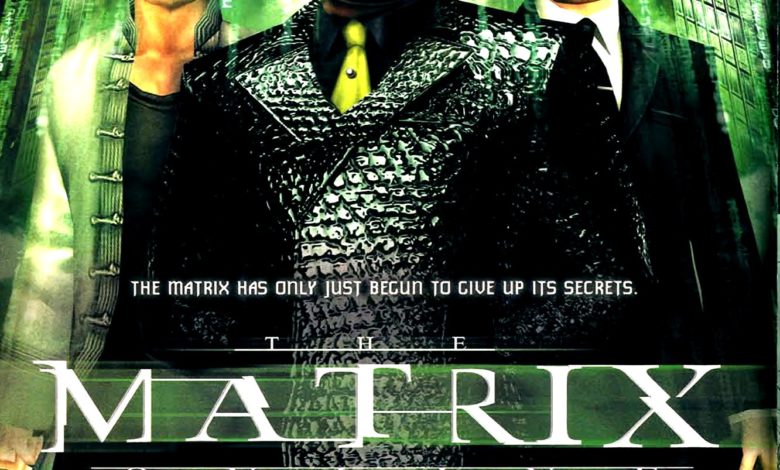
(Re)Enter the Matrix
In 2003, Warner Brothers Interactive and Ubisoft announced they would be publishing an MMO set in the universe of The Matrix. Developed by Monolith Productions, the Matrix Online (MXO) would continue the story after the events of the third film. However, Ubisoft would later back out of the distribution deal with Warner Brothers, prompting SEGA to step in to help get MXO onto store shelves in 2005.[1]
It was a short-lived commitment, with both SEGA and Warner Brothers soon leaving the game in the hands of (then) MMO juggernaut Sony Online Entertainment (SOE). SOE made several changes to the game’s architecture, slimming down the size of the game world and tinkering with the combat system.[2] Other controversial changes, including in-game advertising, were made in an effort to keep the game running and attract more players. However, in 2009, SOE shut MXO down for good.[3]
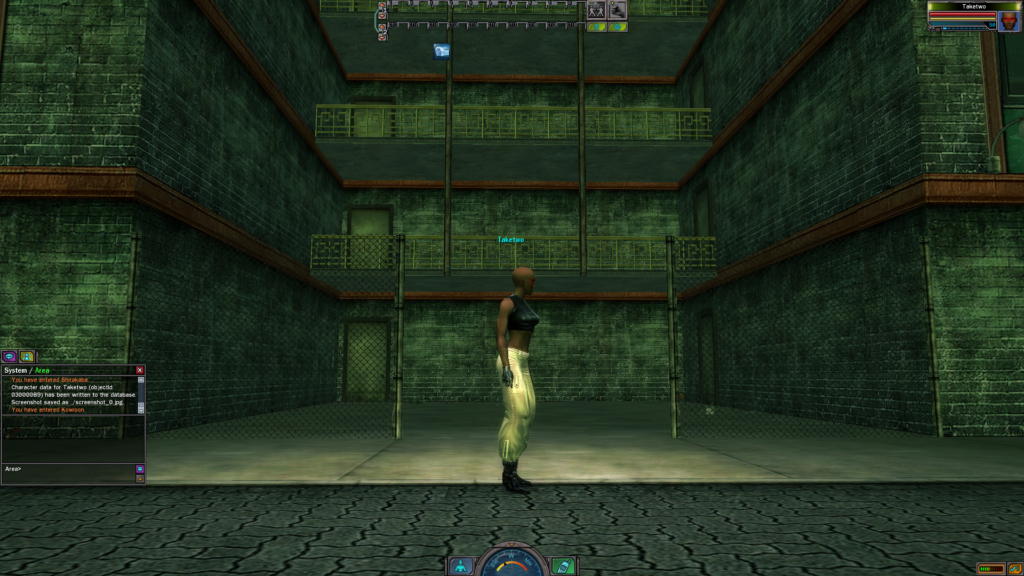
It didn’t take long for fans to pick up the pieces and begin reassembling MXO after its cancellation. Several projects were, and still are, in production, including Hardline Dreams and (played here) MXO Emu, attempting to bring the MMO back to life, one piece at a time.
MXO boasted, despite its uneven critical reception, a highly ambitious system of world building and player interaction. Characters from the films appeared in the game world, controlled by humans acting as said characters.[4] Player choice and direction had an impact on the story’s direction as well, with cinematics and story arcs influenced by community and faction engagement. MXO wasn’t supposed to be a linear set of missions to play, but rather an ever-evolving story where players had a direct influence on lore.
MXOemu.info launched a playable build of the dead MMO in 2010, and it has been continually updated over the past eleven years. The most recent build of the project, released in July 2021, is the one explored in this article. It is, aside from promotional material released near the game’s launch, my first real experience with the game. Having no expectation as to how well any given part of the game has been emulated or rebuilt, the following are my musings after stepping into MXO some fifteen years out of context.
Jacking In
An MMO’s infrastructure is shared between online and local files. In a dead MMO like MXO, attempting to recover and rewrite code is a slow and often puzzling process. As a result, you don’t so much get a game as you do an interactive space. In this build of MXO Emu, there are no goals to complete, no tiers of accomplishment, and no activities to progress the game or story therein. MXO Emu is, like its name suggests, an emulation of the game, not a perfect recreation of it. It is still very much a work in progress, with aspects like combat, missions, and just about anything else you’d associate with “gameplay” missing.
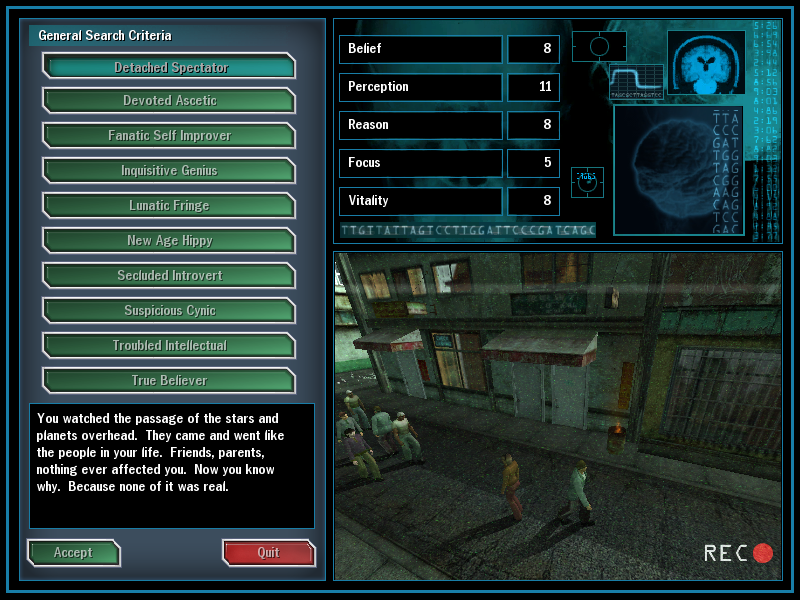
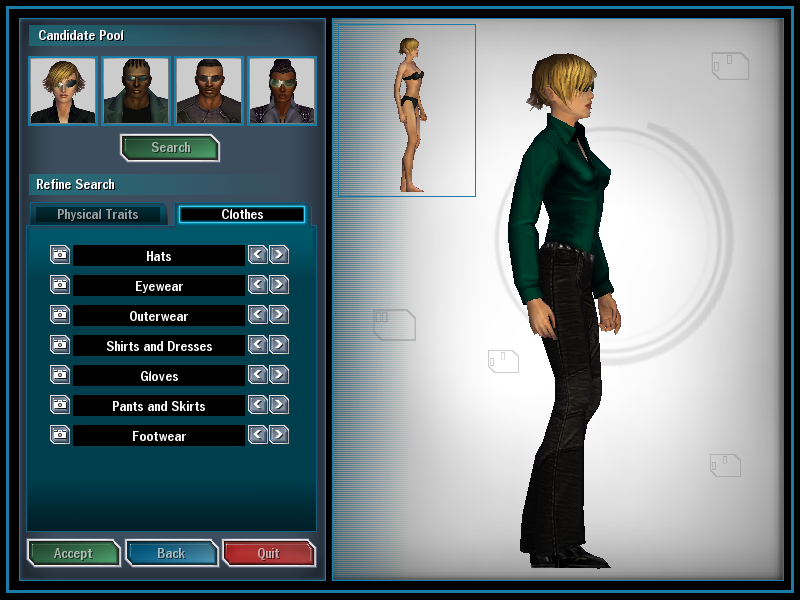
Starting the MXO Emu client up for the first time, you are greeted with a CCTV feed from within the Matrix; the crew of a Zion-based hovercraft looking for their next redpill, prompting the character creation screen. Here, you choose an archetype, forming your avatar’s personality traits. After that, you can begin to assemble your avatar’s physical characteristics. Though attributes and clothing are limited to only a handful of categories, each of which only have a select few options, you can still make yourself a semi-unique looking character. Though undoubtedly a bit primitive looking, especially compared to the caliber of visuals that were about to be ushered in by seventh generation consoles the following year, the character builds do capture that “Matrix” look, with cool leather crop tops and stylish trench coats.
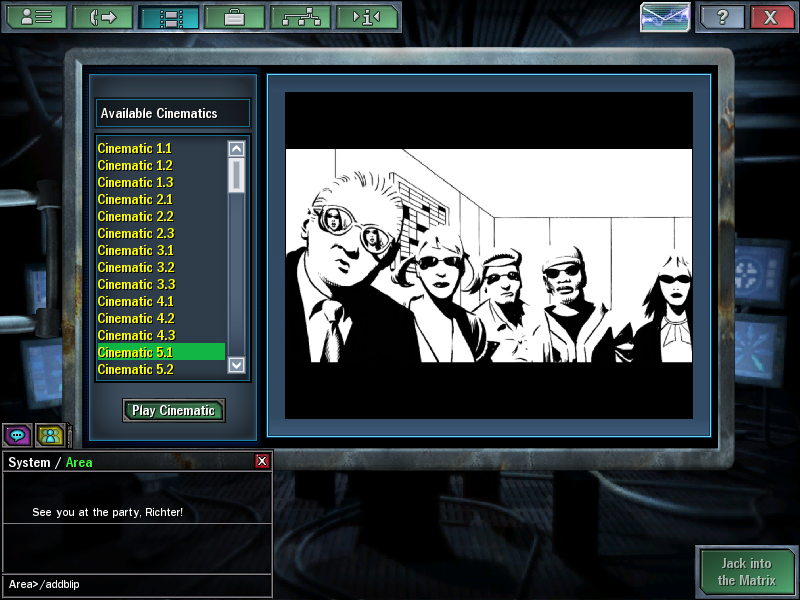
Matrix Online character creation
Once you have finalized your character, MXO Emu abruptly drops you onto the bridge of the ship. Here, you can access cinematics, catching up on the game’s story as it existed in its heyday – theoretically, at least. None of the videos would play for me, unfortunately, but hopefully they’ll be accessible one day.
Moving to the character abilities screen, you can see what type of skills are equipable to your avatar (all of them, as it turns out). You begin MXO Emu at level 50, and are able to dole out your (unearned) XP to skill trees as you see fit. I made a few quick choices, overpowering my character far beyond my comprehension of how any of the abilities actually fit into the gameplay, and then moved to the hardline selection screen: a list of payphones (spawn points) by which to enter the Matrix.
Mega City is divided into several quadrants, including Downtown, Richland, and Westview. There are also a number of international locations, comprised of Asian locals like Kowloon and Shinjuku. Another several unnamed coordinates are also available, leading to places like an island off the shores of Mega City.
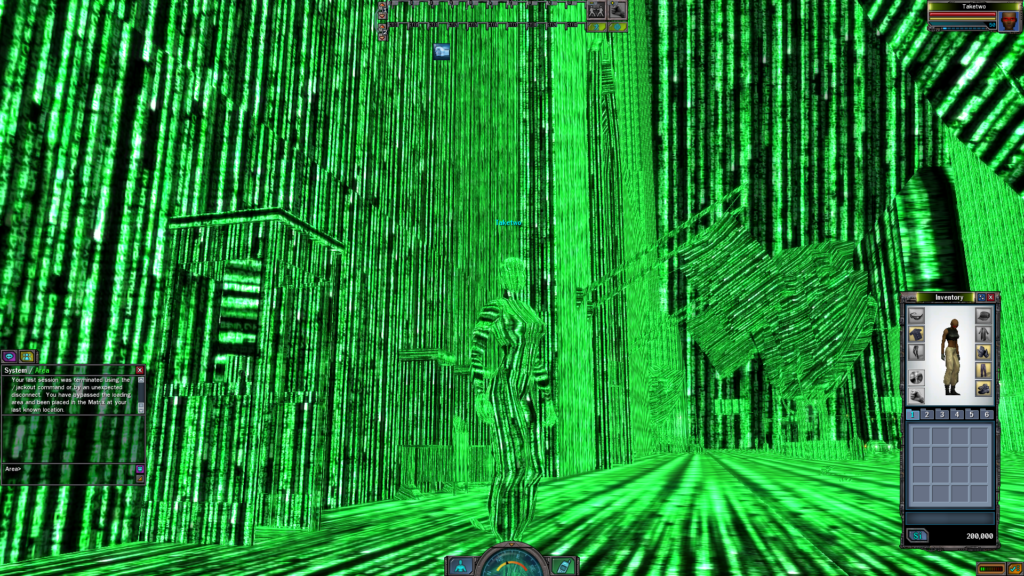
A sprawling, digital world
Jacking in to the Matrix, the game retextures all surfaces in the films’ signature running green code while loading. After a few seconds, the code becomes translucent before disappearing completely, putting you into the simulation world (or in this case, simulation of a simulation of a simulation world). Having had no tutorial or instruction on how to play, I found my footing by way of typical MMO controls (holding both mouse buttons or using WASD for navigation) and began strolling about.
MMOs are known to awe with their impressive scale, but MXO is on another level. Not only does Mega City sprawl out in a (seemingly) infinite number of directions, but the towering skyscrapers, knots of overpasses, and labyrinths of back alleyways reduces your vantage more than a few blocks at a time, making the city feel exponentially bigger than it probably is. While I’m not sure if MXO Emu uses SOE’s reduced floorplan or SEGA’s original, the landscape is nevertheless striking.
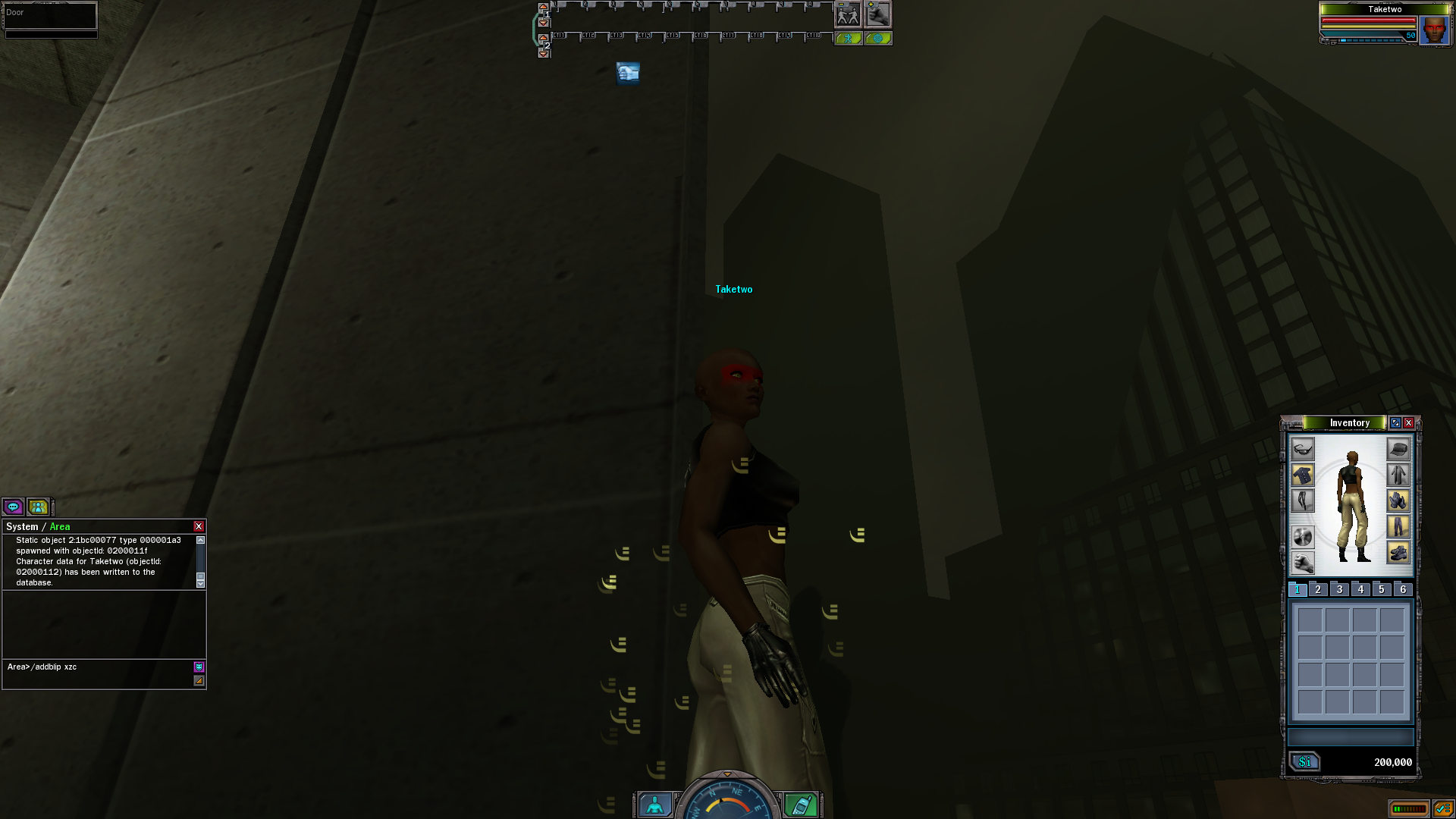
A cool, downtempo soundtrack of trance and techno tunes laced with heavy synth scores your walk through the streets. A day/night cycle is also in place, though with a heavy green-tinted fog (depending on the time of day) the game carries a foreboding coat of darkness wherever you go. This makes MXO Emu feel (appropriately) dreamlike, the sound and atmospheric effects going a long way in amplifying the scale, and emptiness, of the environments.
Like the Matrix is meant to be a machine’s interpretation of human reality, being almost but not quite accurate, so too is MXO Emu an interpretation, or distorted, recreation of a digital simulation. A waterfront park square I stumbled upon, for example, assembled from brick and peppered with benches and a piece of public art in the centre, felt almost surreal; too big, and too empty, for its supposed purpose. Looking out to the water I felt a brief sensation of freedom, though that was quickly stolen when I noticed the foreboding shadow of buildings across the water. As I would come to see at other waterfronts and lookouts throughout the city, the shadows of buildings are always in view, blocking out the horizon, like a wall meant to remind people they are trapped.
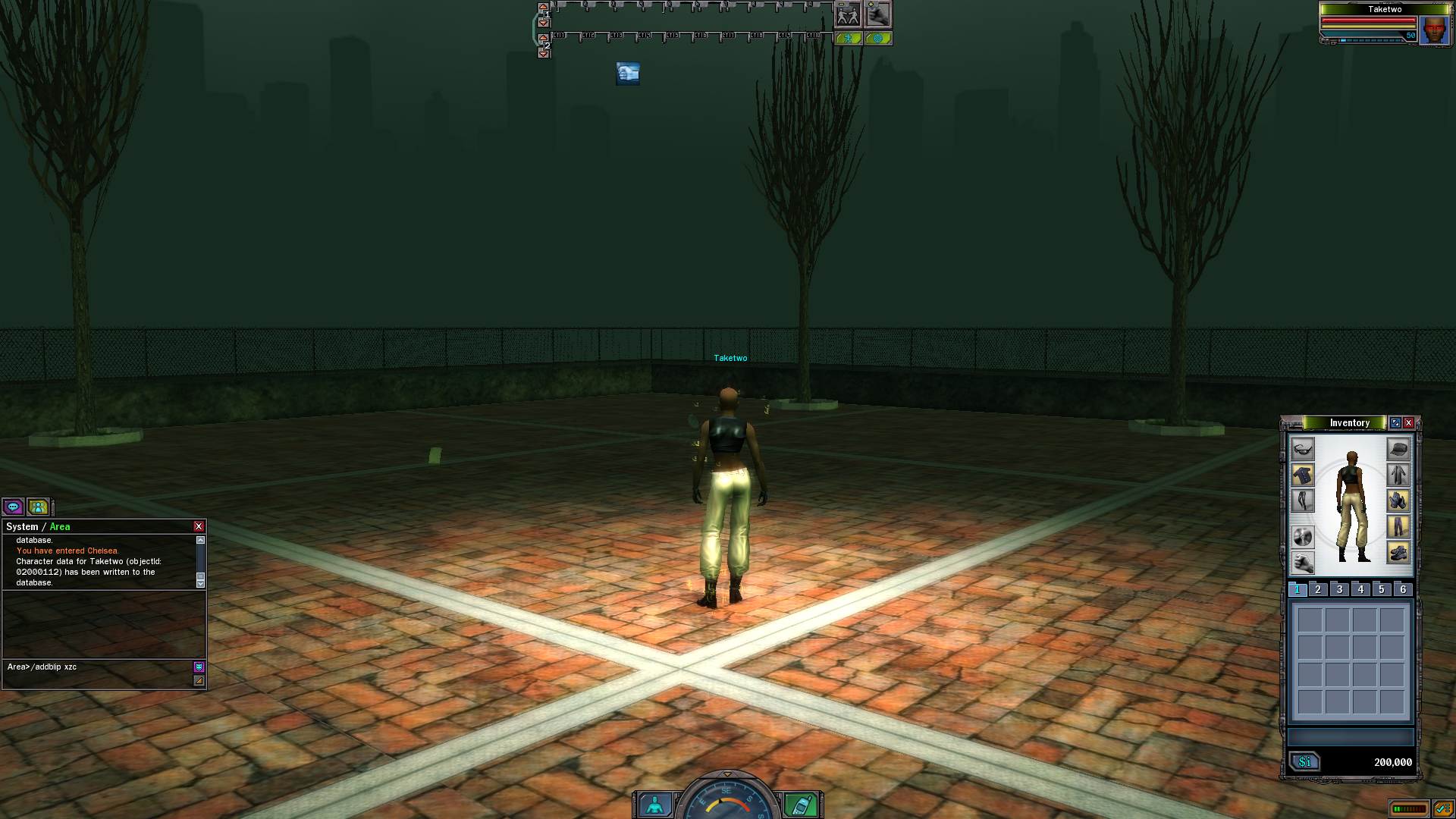
Getting into the nitty gritty details
Moving back through Westview and into Downtown, I crossed several area changes, most of which were labeled “restricted areas”, though I had no idea what that meant. It then dawned on me that I had not seen any agents, or enemies, of any kind. As I didn’t know how to fight or use any combat abilities, that was fine, but I would soon find out that combat is in fact not yet functional in MXO Emu. Many other functions are missing as well, including, of all things, ladders (prompting me to contact Admin if I knew what “ladder” was). Some equipped abilities, like Hyperjump and Hypersprint, are functional, but for the most part I was forced to take it slow, travelling to my destinations on foot.
Many vendors are operational, however, and I bought a sidearm from a shady dealer in Kowloon and browsed a homeless man’s cyberware, just for kicks. Though none of these factor into the game right now, MXO Emu is first and foremost a preservation project in its current state, and being able to see these digital artefacts is really cool, even if not practical.
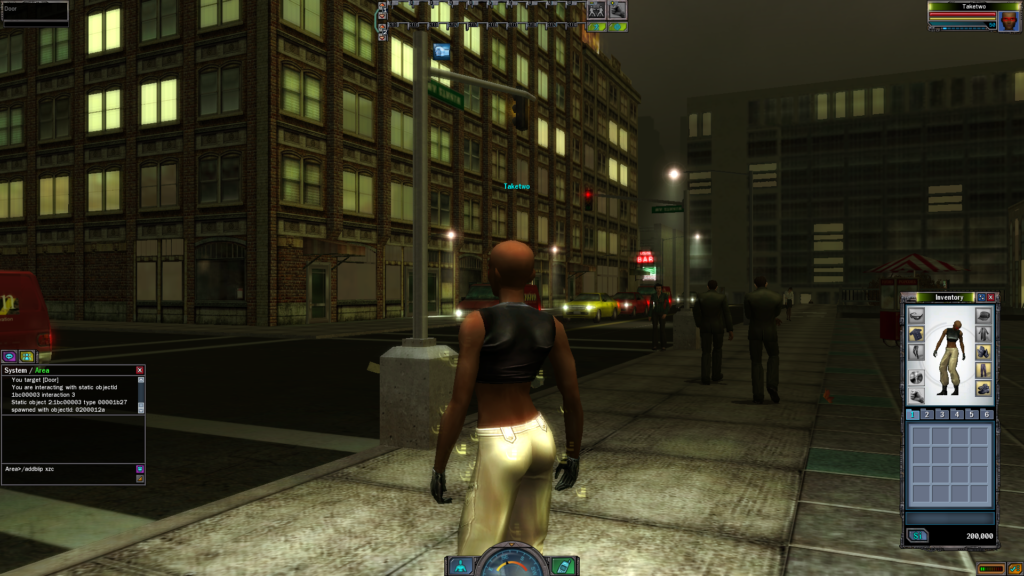
Though a select few doors in Richland opened to reveal nothing but placeholder textures connoting “wall”, I was able to explore many of the skyscrapers in the Downtown sector in their entirety. Entering the lobby of one of the buildings, I took a moment to appreciate the polished granite floor and concrete walls, which were decorated with appropriately safe and unremarkable artworks.
I wandered through several unmarked doors, quickly becoming lost in the oblique tangle of rooms. Eventually, signs for the elevator and stairwell came into view, and I made my way up several floors. Here, I explored empty offices and rooms, looking out the windows to the streets and rooftops below. I thought of how exciting the adventures must have been in these buildings when the game was functional; fighting agents, sprinting up stairwells, leaping from building to building, and trying to find a hardline out. Now, all of that is gone; or, perhaps just waiting to happen once more.
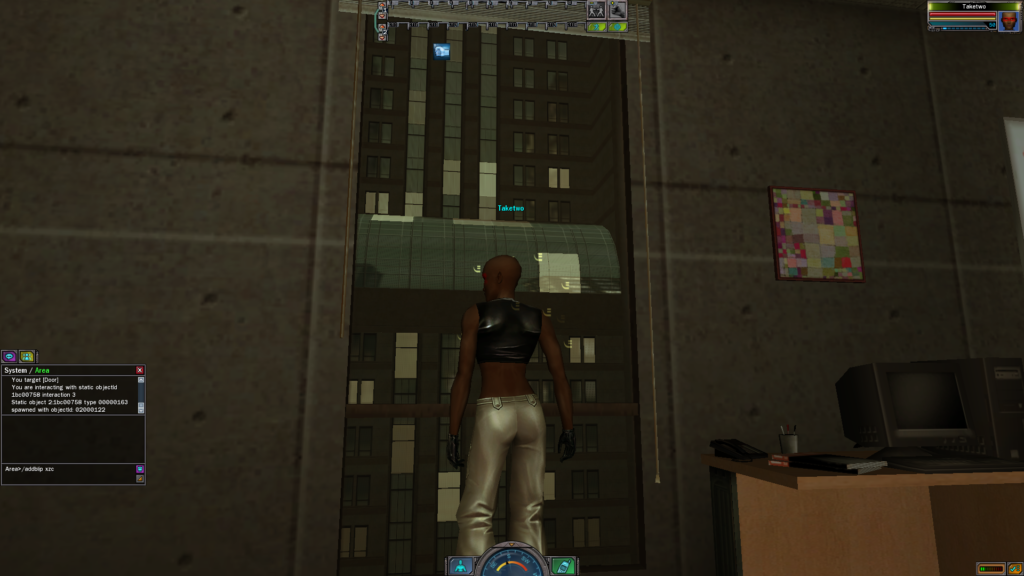
Wandering the empty spaces proved somewhat surreal, as though I were seeing something private left behind by the former residents of this strange digital world. Though the architecture certainly suits the bleak, repetitious, and artificial flavor of the films, in MXO Emu, the context and functionality are removed, making the experience unsettlingly liminal. Ignore the game’s chat functionality, and MXO Emu is a private digital purgatory. It’s perhaps an unintended result of stripping the Matrix down to its core parts, creating a more impactful view of the Wachowski’s world than intended.
This is strengthened by the NPCs, who spout out a number of predetermined lines. Again, in the full game, these bluepills would have seemed appropriately blind to the greater context of their surroundings. Here, without purpose or function, and being some of the only points of interaction in the game world, their droning and uninteresting lives take on a new meaning. Resurrected in this emulation, they wander the streets, asking where they can get a good cup of coffee, or fantasizing about being let into an upscale dance club. It actually made me sad talking to them, which is not something I can say I’ve ever felt in a JRPG when I enter an NPC’s house for no reason other than to break their pots or look in their cupboards. It sounds silly, but I think perhaps this feeling of pity was amplified by the fact that this is an emulated version of a dead game. The NPCs, and the whole world, now exist in limbo, brought back to life without all of their parts in working order. It paints the project in a sort of beautiful, but tragic, light. Fate, it seems, is not without a sense of irony.
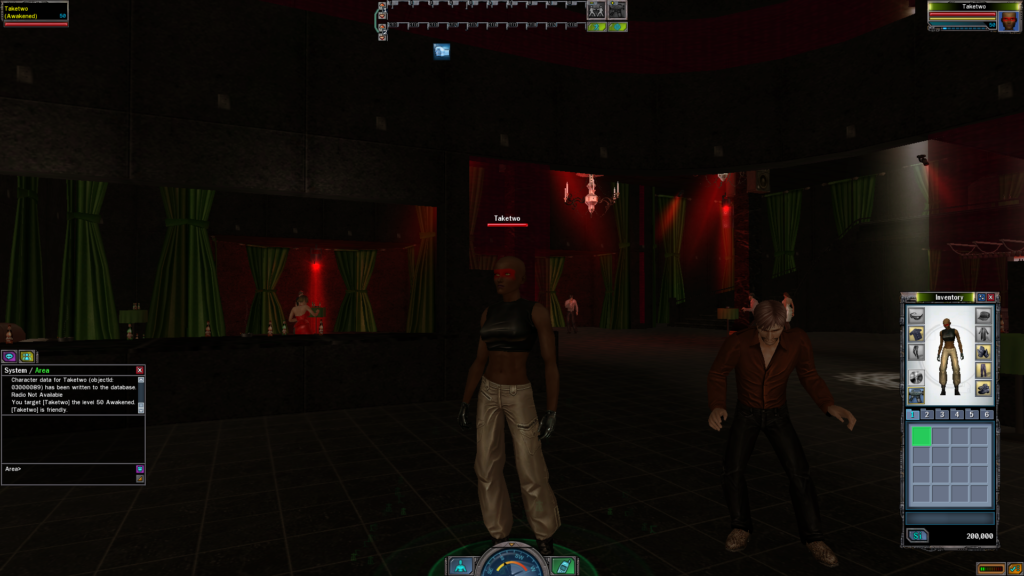
Eventually, I found my way into one of the game’s infamous dance clubs, though I was unable to figure out how to dance, so I just stood there (like I do at dance clubs in real life, fittingly). While visiting the club was fun, as social gatherings were apparently a big part of the original game’s appeal, I had yet to run into another player in the game world. Looking at the emulator’s forums, meetups are organized from time to time, should you want to explore (or reminisce about) the game with other players.[5]
During my second session, I spent a great deal of time interacting with rest places, like chairs and benches. I sat down in an empty living room, in a boardroom on the top floor of a skyscraper, lounged in the basement of a temple, and climbed to the top of a mysterious concrete pyramid in the middle of an island off the shores of the city, soaking in the extreme solitude.
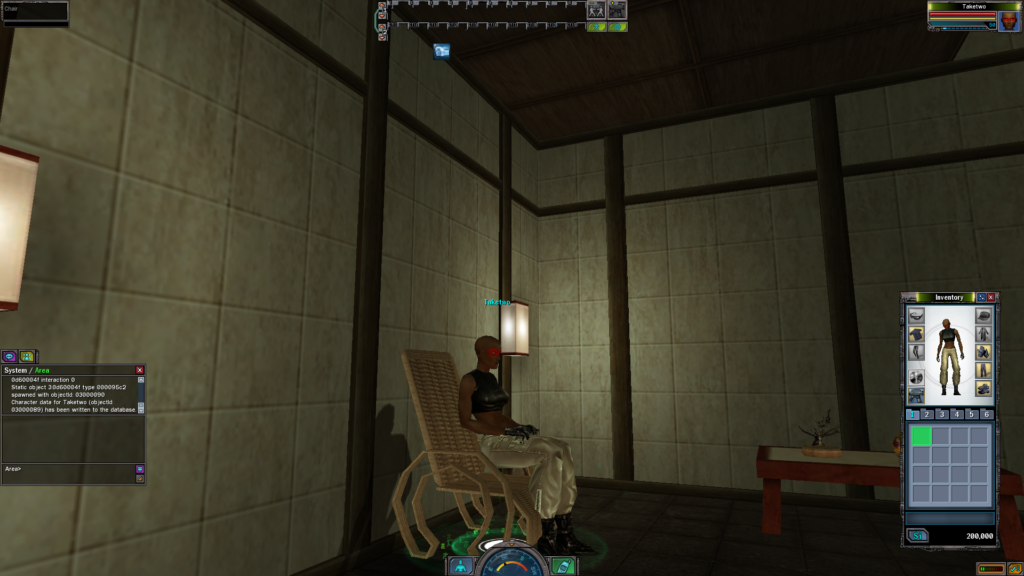
It wasn’t until I happened to look down to the chat box that I noticed someone was trying to communicate with me. It may sound melodramatic, but being abruptly reminded that I wasn’t alone in the world sent chills down my spine. An organized meetup with other players was one thing, but what about running around in the city, alone, for hours, only to have someone pull up a chair next to you in the basement of building, or to spot one and other across the shoreline? I knew why I was playing MXO Emu, but what were others doing in this online relic? Suddenly, the multiplayer aspect of MXO Emu became frightening, and I decided to hardline out.

All I’m Offering is the Truth, Nothing More
Though SEGA’s short-lived association with Monolith’s short-lived MMO only barely qualify the game as a SEGA product, their backing of this highly ambitious vision for multiplayer gaming was nevertheless important, even if ultimately unsuccessful. My time in MXO Emu certainly left an impact, albeit for wholly unexpected reasons. Unlike playing an old single player game you may have missed out on, playing an MMO after its conclusion feels almost taboo, or forbidden. Ruins in the real world are worn down by the elements and buried by earth, their function or context lost to time. Digital ruins are covered in no such dust, nor withered by natural forces, and thus appear deceptively pristine. Instead, they are buried in code, but must, like real world ruins, be studied in the context of their former purpose. Playing MXO Emu is akin to wandering ancient ruins. Though they may not serve any practical purpose nowadays, we still try to maintain them as they are. We want to unearth what life was like in these places, while also revelling in the beauty of their ruin.
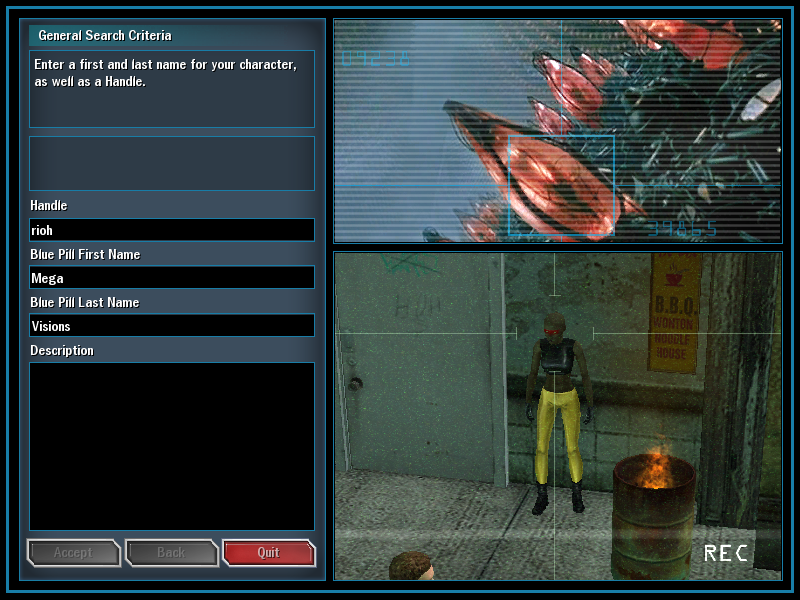
Of all the dead games you could explore, the fact that MXO is one of them seems somewhat ironic. Like the Matrix being rebuilt anew whenever certain criteria are met from a cultural awakening, programming error, or war, the fan build of MXO is an attempt to copy and recreate not only a piece of digital media, but the time in which it existed. It is more an explorative art piece than game. Yet, even if it never becomes fully playable, there is still something alluring about being able to find your way into a Kowloon hotel and sit in a chair, alone, admiring the artificial atmosphere in a space no one may ever see or experience again.
Perhaps MXO will be restored to its original state one day. Perhaps not. Though a fully functional version of MXO would be fun to try, MXO Emu is enjoyable (and a bit spooky) for a host of reasons. As long as you don’t mind running into a few other ghosts in the machine, it’s a venture I can wholeheartedly recommend.
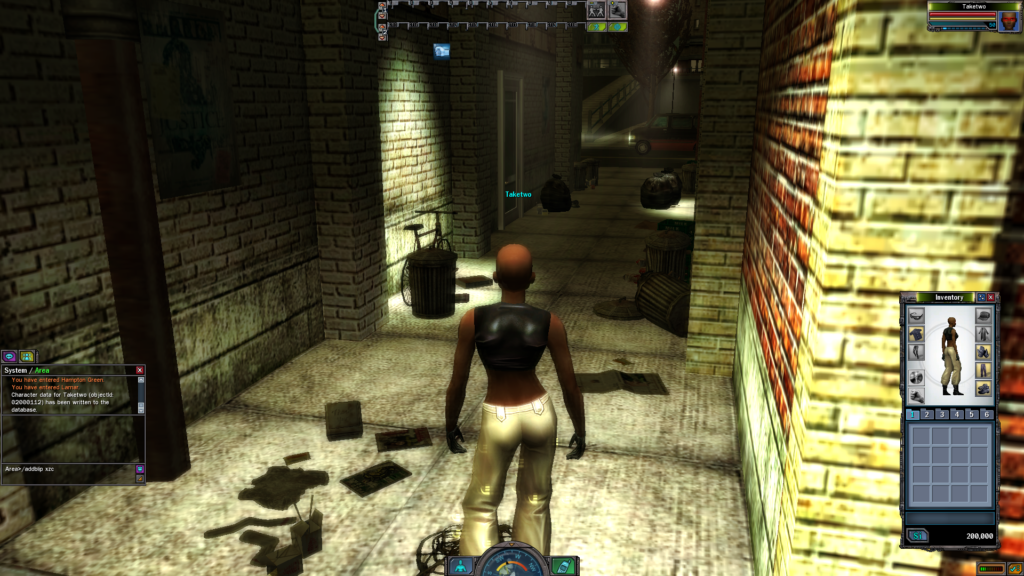
References
Boembeke, Brice. “Review.” Accessed November 19, 2021. http://www.gamechronicles.com/reviews/pc/matrixonline/matrixonline.htm
Gurwin, Gabe. “The Matrix Ressurection Seemingly Hints At Link To Dead MMO.” Accessed November 19, 2021. https://www.gamespot.com/articles/the-matrix-resurrections-seemingly-hints-at-link-to-dead-mmo/1100-6496061/
Meta Critic, 1UP. “The Matrix Online.” Accessed November 19, 2021. https://www.metacritic.com/game/pc/the-matrix-online
Milli63. “Mxoemu vs hardlinedreams?” Accessed November 19, 2021. https://www.reddit.com/r/matrix/comments/i1sa5q/mxoemu_vs_hardlinedreams/
The Matrix Online. Accessed November 19, 2021. https://www.mxoemu.info/
The Matrix Online Emulator. “Monthly MxO community meet-ups.” Accessed November 19, 2021. http://mxoemu.info/forum/showthread.php?tid=2754&highlight=dance
Thorson, Tor. “Sega to copublish Matrix Online.” Accessed November 19, 2021. https://www.gamespot.com/articles/sega-to-copublish-matrix-online/1100-6096613/
Walton, Mark. “Sony to unplug Matrix Online July 31.” Accessed November 19, 2021. https://www.gamespot.com/articles/sony-to-unplug-matrix-online-july-31/1100-6210479/
[1] Tor Thorsen, “Sega to copublish Matrix Online,” Gamespot, accessed November 19, 2021, https://www.chicagomanualofstyle.org/tools_citationguide/citation-guide-1.html
[2] Mark Walton, “Sony to unplug Matrix Online July 31,” Gamespot, accessed November 19, 2021, https://www.gamespot.com/articles/sony-to-unplug-matrix-online-july-31/1100-6210479/.
[3] Ibid.
[4] 1UP, “The Matrix Online,” Metacritic, accessed November 19, 2021, https://www.metacritic.com/game/pc/the-matrix-online
[5] Calaeus, “Monthly MxO community meet-ups,” The Matrix Online Emulator, accessed November 19, 2021, http://mxoemu.info/forum/showthread.php?tid=2754&highlight=dance

